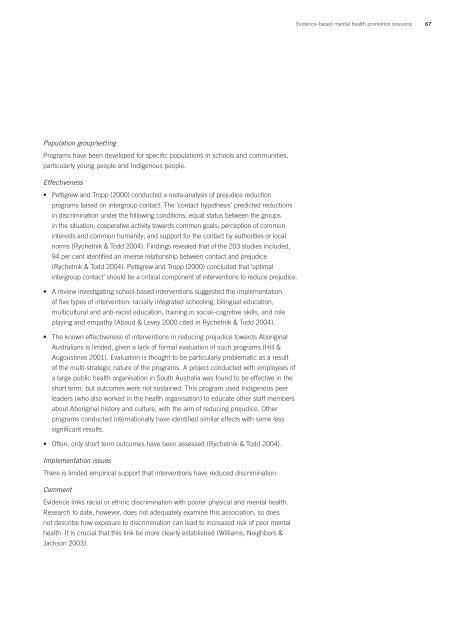Evidence-based mental health promotion resource - health.vic.gov.au
Evidence-based mental health promotion resource - health.vic.gov.au
Evidence-based mental health promotion resource - health.vic.gov.au
Create successful ePaper yourself
Turn your PDF publications into a flip-book with our unique Google optimized e-Paper software.
<strong>Evidence</strong>-<strong>based</strong> <strong>mental</strong> <strong>health</strong> <strong>promotion</strong> <strong>resource</strong>67Population group/settingPrograms have been developed for specific populations in schools and communities,particularly young people and Indigenous people.Effectiveness• Pettigrew and Tropp (2000) conducted a meta-analysis of prejudice reductionprograms <strong>based</strong> on intergroup contact. The ‘contact hypothesis’ predicted reductionsin discrimination under the following conditions: equal status between the groupsin the situation; cooperative activity towards common goals; perception of commoninterests and common humanity; and support for the contact by <strong>au</strong>thorities or localnorms (Rychetnik & Todd 2004). Findings revealed that of the 203 studies included,94 per cent identified an inverse relationship between contact and prejudice(Rychetnik & Todd 2004). Pettigrew and Tropp (2000) concluded that ‘optimalintergroup contact’ should be a critical component of interventions to reduce prejudice.• A review investigating school-<strong>based</strong> interventions suggested the implementationof five types of intervention: racially integrated schooling, bilingual education,multicultural and anti-racist education, training in social–cognitive skills, and roleplaying and empathy (Aboud & Levey 2000 cited in Rychetnik & Todd 2004).• The known effectiveness of interventions in reducing prejudice towards AboriginalAustralians is limited, given a lack of formal evaluation of such programs (Hill &Augoustinos 2001). Evaluation is thought to be particularly problematic as a resultof the multi-strategic nature of the programs. A project conducted with employees ofa large public <strong>health</strong> organisation in South Australia was found to be effective in theshort term, but outcomes were not sustained. This program used Indigenous peerleaders (who also worked in the <strong>health</strong> organisation) to educate other staff membersabout Aboriginal history and culture, with the aim of reducing prejudice. Otherprograms conducted internationally have identified similar effects with some lesssignificant results.• Often, only short term outcomes have been assessed (Rychetnik & Todd 2004).Implementation issuesThere is limited empirical support that interventions have reduced discrimination.Comment<strong>Evidence</strong> links racial or ethnic discrimination with poorer physical and <strong>mental</strong> <strong>health</strong>.Research to date, however, does not adequately examine this association, so doesnot describe how exposure to discrimination can lead to increased risk of poor <strong>mental</strong><strong>health</strong>. It is crucial that this link be more clearly established (Williams, Neighbors &Jackson 2003).



